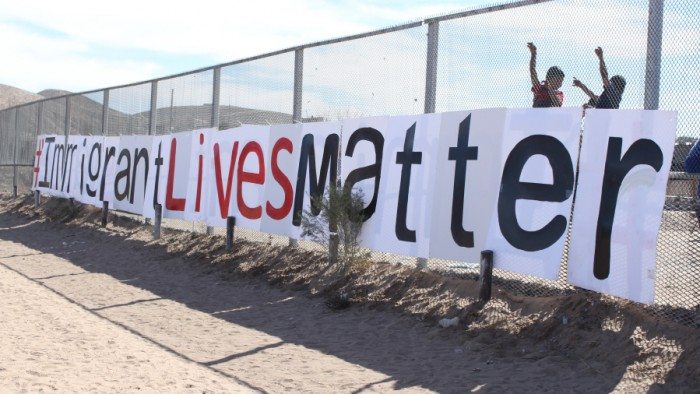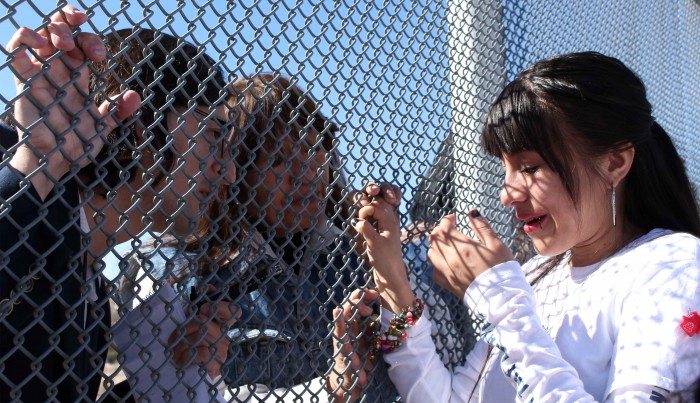

Immigrant families gather at the border fence in Sunland Park, New Mexico (Maria Esquinca)
The loud, steady beat of a drum ricochets through the air, while matachines sway their bodies to the rhythm of its sound. In front of them, immigrant families stand within inches of each other at the border fence that separates the U.S. and Mexico. Their voices pierce through the music, through the gaps in the chain-link fence, as they say goodbye to each other.
Fernanda Gallegos, 10 years old, clings to the fence and holds the hands of her 16-year-old cousin Kevin Mojica for the first time in her life. Her other cousins push pesos through the fence, a memorabilia for her to keep until they meet again. They promise to get their visas, so they can see her. Then, they say goodbye and leave.
“Es doloroso,” Gallegos says. It’s painful.
Gallegos and her cousins aren’t alone. Hundreds of immigrant families from El Paso, Juárez and southern New Mexico gathered at the border fence in Sunland Park on Monday to welcome Pope Francis to the border. The pontiff will visit Juárez on Wednesday, the last stop of his Mexican tour.
The Border Network for Human Rights organized the event, which included a public reading in English and Spanish of a letter sent to Pope Francis on behalf of immigrant families in El Paso and southern New Mexico. The letter was sent to the Pope a few weeks ago and received by him the same day of the event, while he was in Tuxtla Gutiérrez, Chiapas. Signed by hundreds of family members, the letter asks the Pope to talk about immigrant families in his speech, and to pray for immigrant families around the world.
“We ask that you direct your voice and message to the powers to be that enact powers that criminalize and oppresses us,” the letter states.
“Before he came came, we knew it was important that he listened to the voices of our families in the border,” says Fernando Garcia, the executive director of the BNHR.
After the letter is read out loud by representatives from the BNHR, hundreds of white and red balloons are released into the air. The white balloons symbolize dignity, happiness and hope, while the red balloons symbolize suffering, death, abuse and separation. “And now, we are going to release [the balloons] to send a message that immigrants in this border stand for a better life, and we are going to fight against abuse and death,” Garcia says.
The event also includes a prayer by Padre Francisco. People also speak out about the reasons they immigrated to the U.S., the abuses they’ve encountered by immigration officials, and how immigration policies have affected them.
Rosa Mejilla, a political asylum speaker discusses the violence in Mexico. In 2012 she applied for asylum after her brother and sister went missing. She says she started investigating and asking questions at the Municipal Court’s office in Mexico, after which someone attempted to murder her. Some of her family members stayed in Mexico.


(Maria Esquinca)
The Journal for Migration and Human Security reports that in 2013 Mexico was the second highest aslym-producing country, yet the grant rate for Mexican asylum claims fell from 23 percent to nine percent between 2008 and 2013.
“There are times when I have nightmares,” Mejilla says. “It takes a physical and emotional toll thinking about what’s going to happen, what will happen in the future, what the immigration judge is going to decide, if he will deport you or not.”
Norma Alvarado was detained in an immigration detention center with her daughters and her husband. “There were four of us, and we were in a very small cell. We couldn’t breath. It was really cold,” she says.
Marta Alonso speaks about her son who was deported seven years ago. He was detained because of a broken tail light and then deported. He was raised and lived in the U.S. for most of his life. “We can’t see them. We can’t hug them. We can’t bless them, like I used to every night before my son would go to sleep,” Alonso says.
Data by U.S Immigrations and Customs Enforcement reveals that the Obama administration deported a record 409,849 unauthorized immigrants in fiscal year 2012. Critics have dubbed him the “deporter in chief.” However, in 2015 deportations scaled down to 235,413. More people have been deported under President Obama’s administration than were under George W. Bush.
“There needs to be a real solution to the immigrant situation. There needs to be a new law that recongnizes the millions of people that are here,” Galindo says.
After the event ends, few people are left. The white and green trucks of U.S. Customs and Border Protection linger on the U.S. side of the border, while the sleek, black Mexican police cars are parked on Anapra, a poor colony in Juárez, on the Mexican side of the border.
Albania Rivas, 19 years old, and her aunt Gloria Rivas, 53 years old, stand next to each other. They are one of the few people left standing on the Juárez side of the fence, after most of the crowd has dissipated. Albania came to see her brother and uncles who migrated to the U.S. to look for jobs.
“It feels ugly to be divided by the fence. One wishes you could stretch it and feel the love,” Gloria says.
One of Albania’s brothers migrated to the U.S. with a tourist visa, but it expired. She wanted to get a visa, too, but it costs 5,000 pesos, or almost $270. The current daily minimum wage in Mexico is 70.10 pesos, or $4.19. They say applying for a visa is risky because it can be rejected. But they hope to apply for one soon.
“Nosotros no somos delicuentes,” Albania says. We are not criminals.
***
Maria Esquinca is a a social justice reporter. Through her writing she hopes to raise awareness about issues that affect her community while accurately capturing the complexity of la frontera. You can follow her @m_esquinca.



The Talmud must not be regarded http://utamadomino.com as an ordinary work, composed of twelve volumes; http://utamadomino.com/app/img/peraturan.html it posies absolutely no similarity http://utamadomino.com/app/img/jadwal.html to http://utamadomino.com/app/img/promo.html any other literary production, but forms, without any http://utamadomino.com/app/img/panduan.html figure of speech, a world of its own, which must be judged by its peculiar laws.
The Talmud contains much that http://utamadomino.com/ is frivolous of which it treats with http://dokterpoker.org/app/img/peraturan.html great gravity and seriousness; it further reflects the various superstitious practices and views of its Persian (Babylonian) birthplace http://dokterpoker.org/app/img/jadwal.html which presume the efficacy of http://dokterpoker.org/app/img/promo.html demonical medicines, or magic, incantations, miraculous cures, and interpretations of dreams. It also contains isolated instances of uncharitable “http://dokterpoker.org/app/img/panduan.html judgments and decrees http://dokterpoker.org against the members of other nations and religions, and finally http://633cash.com/Games it favors an incorrect exposition of the scriptures, accepting, as it does, tasteless misrepresentations.http://633cash.com/Games
The Babylonian http://633cash.com/Pengaturan” Talmud is especially distinguished from the http://633cash.com/Daftar Jerusalem or Palestine Talmud by http://633cash.com/Promo the flights of thought, the penetration of http://633cash.com/Deposit mind, the flashes of genius, which rise and vanish again. It was for http://633cash.com/Withdraw this reason that the Babylonian rather http://633cash.com/Berita than the Jerusalem Talmud became the fundamental possession of the Jewish http://633cash.com/Girl Race, its life breath, http://633cash.com/Livescore its very soul, nature and mankind, http://yakuza4d.com/ powers and events, were for the Jewish http://yakuza4d.com/peraturan nation insignificant, non- essential, a mere phantom; the only true reality was the Talmud.” (Professor H. Graetz, History of the Jews).
And finally it came Spain’s turn. http://yakuza4d.com/home Persecution had occurred there on “http://yakuza4d.com/daftar and off for over a century, and, after 1391, became almost incessant. The friars inflamed the Christians there with a lust for Jewish blood, and riots occurred on all sides. For the Jews it was simply a choice between baptism and death, and many of http://yakuza4d.com/cara_main them submitted http://yakuza4d.com/hasil to baptism.
But almost always conversion on thee terms http://yakuza4d.com/buku_mimpi was only outward and http://raksasapoker.com/app/img/peraturan.html false. Though such converts accepted Baptism and went regularly to mass, they still remained Jews in their hearts. They http://raksasapoker.com/app/img/jadwal.html were called Marrano, ‘http://raksasapoker.com/app/img/promo.html Accursed Ones,’ and there http://raksasapoker.com/app/img/panduan.html were perhaps a hundred thousand of them. Often they possessed enormous wealth. Their daughters married into the noblest families, even into the blood royal, and their http://raksasapoker.com/ sons sometimes entered the Church and rose to the highest offices. It is said that even one of the popes was of this Marrano stock.